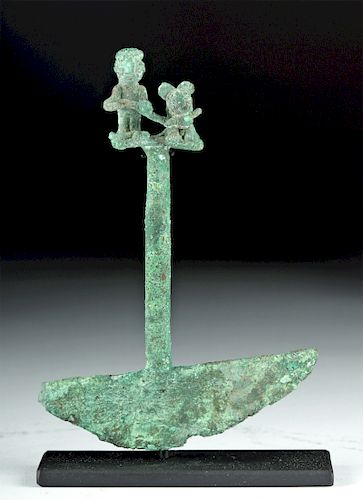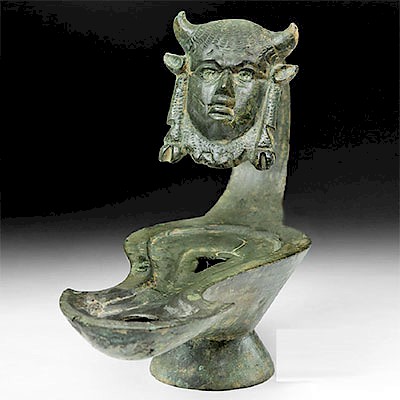Inca Copper Tumi - Man & Jaguar
Lot 161
About Seller
Artemis Gallery
686 S Taylor Ave, Ste 106
Louisville, CO 80027
United States
Selling antiquities, ancient and ethnographic art online since 1993, Artemis Gallery specializes in Classical Antiquities (Egyptian, Greek, Roman, Near Eastern), Asian, Pre-Columbian, African / Tribal / Oceanographic art. Our extensive inventory includes pottery, stone, metal, wood, glass and textil...Read more
Estimate:
$1,100 - $1,650
Absentee vs Live bid
Two ways to bid:
- Leave a max absentee bid and the platform will bid on your behalf up to your maximum bid during the live auction.
- Bid live during the auction and your bids will be submitted real-time to the auctioneer.
Bid Increments
| Price | Bid Increment |
|---|---|
| $0 | $25 |
| $300 | $50 |
| $1,000 | $100 |
| $2,000 | $250 |
| $5,000 | $500 |
| $10,000 | $1,000 |
| $20,000 | $2,500 |
| $50,000 | $5,000 |
| $100,000 | $10,000 |
| $200,000 | $20,000 |
About Auction
By Artemis Gallery
Sep 27, 2018
Set Reminder
2018-09-27 10:00:00
2018-09-27 10:00:00
America/New_York
Bidsquare
Bidsquare : Antiquities | Asian | Ethnographic
https://www.bidsquare.com/auctions/artemis-gallery/antiquities-asian-ethnographic-3469
Featuring classical antiquities, ancient and ethnographic art from cultures encompassing the globe. Artemis Gallery info@artemisgallery.com
Featuring classical antiquities, ancient and ethnographic art from cultures encompassing the globe. Artemis Gallery info@artemisgallery.com
- Lot Description
Pre-Columbian, south coast Peru, Incan Empire, ca. 1200 to 1532 CE. A wonderful cast-copper ceremonial tumi, a curved, crescent-shaped blade topped by a long tubular handle with a finial decorative motif of a man and a jaguar. The man is standing upon attenuated legs and wears an elaborate cap while holding a slender leash in both hands. The leash is wrapped around the neck of a standing jaguar, with a spotted body and perky ears, shown eating a fish or some other animal. Covered in areas of light-green, dark-green, and russet-hued patina, this is a fabulous example from the ancient Inca! Size: 3.625" W x 5.125" H (9.2 cm x 13 cm); 5.625" H (14.3 cm) on included custom stand.
The tumi was sometimes used to sacrifice llamas to the sun god. The Paracas people, also from the Andes, used the tumi for human trepanation, thought to open the mind to religious enlightenment; it is unknown if the Inca conducted similar practices, but they may have done so. In modern Peru, a tumi on the wall is a symbol of good luck.
Provenance: ex-private southern Florida, USA collection, acquired from Artemis Gallery around 2008; ex-private southwestern USA collection
All items legal to buy/sell under U.S. Statute covering cultural patrimony Code 2600, CHAPTER 14, and are guaranteed to be as described or your money back.
A Certificate of Authenticity will accompany all winning bids.
We ship worldwide and handle all shipping in-house for your convenience.
#136747Surface wear and abrasions commensurate with age, loss to one tip of tumi blade, fading to finer details, and roughness across most surfaces. Nice earthen deposits and great green and russet patina throughout.Condition
- Shipping Info
-
All shipping is handled in-house for your convenience. Your invoice from Artemis Gallery will include shipping calculation instructions. If in doubt, please inquire BEFORE bidding for estimated shipping costs for individual items.
-
- Buyer's Premium



 EUR
EUR CAD
CAD AUD
AUD GBP
GBP MXN
MXN HKD
HKD CNY
CNY MYR
MYR SEK
SEK SGD
SGD CHF
CHF THB
THB














